Pre-novitiation instructions The monastery was surrounded by shady trees and its spacious grounds were well kept; the building were old and solid yet unpretentious. It was eight in the morning and we saw the monks coming back from their daily alms-round.
Daw Daw told us that the monks staying there had to go on alms-receiving rounds every morning in the same old-fashioned way I had known in my childhood. The alms-round. I understood. was done more in the spirit of humility and compassion for the people the necessity. The people were being giving thereby a chance to do deeds of merit by giving a morsel out of their daily food to the monks. The presiding monk received us kindly and we told him we wanted our son to be given pre-novitiation instructions.
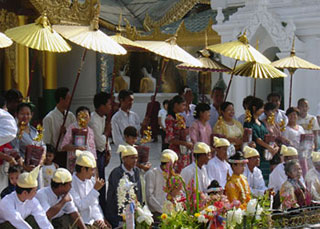
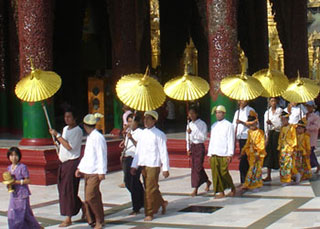
Khin Maung Win was put under the care of a monk who gave him some Pali and Myanmar passages to learn. Since my youngest brother and Daw Daw’s son were going to be novices. all three were to go to the monastery every morning. My younger brother and Daw Daw’s son both of whom were about fifteen has already been novitiated. It was not unusual for a male child to become a novice more than once but there is yet another great occasion for a son… the upa-sampada… ordination at the age of twenty. It is considered a great privilege to have a son.
First novitiation 2.500 years ago.
In the weeks that followed we talked of nothing else. We had to make our son. now nine years old. realise the importance of being a novice. I told him the story of the young princeling Rahula. Buddha’s own son. I never realised its beauty until I presented the story to my nine-year-old-son. We showed him young novices who followed older monks as they went on their morning rounds. We pointed out the young boys in the yellow robes with black bowls cradled in their arms after the fashion of the older monks. Their eyes were downcast. their faces begin.

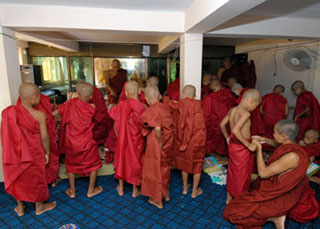
Some two thousand five hundred years ago Rahula. the seven-year-old novice had followed in the footsteps of the Buddha. his father. For seven years the young prince had waited for the Father who had left him when he was a baby in his mother’s amis. He had listened to his mother Yasodhaya’s story of how one sad night his father prince Siddhartha had left the palace on horse-back attended only by his faithful groom.
Where had his father gone? Why had he gone? These. the little boy wanted to know. Yasodhaya told him how the faithful groom had come back with the news that the Prince had gone into the forest after changing his princely attire for a yellow robe. Why had he done this? He had gone into retirement to seek the way out of pain. suffering and death: when he had found it he would come back and teach men the Truth he had found. After seven years. he came back with his head shorn. robed in coarse yellow cloth. with the black bowl cradled in his arms. He walked. with downcast eyes. the street he once rode in grandeur attended by foot-soldiers. mounted guards. elephants and chariots. His father King Suddhodana was filled with shame and anger. He chided Him for disgracing the Sakkya warrior race to which he belonged. The Buddha answered that he no longer belonged to the Sakkya race but to the race of the Buddhas before Him and the Buddhas after. A strange meeting it was; a great King. proud and mighty in warrior-mail meeting his son in hermit-raiment. The son had become greater than the mightiest of kings. for he had become the greatest Teacher. One who would teach the way out of sorrow. suffering. pain and death. Happy yet tearful was the meeting of Rahula’s mother and the Buddha. The whole palace was agog with the news of the Buddha’s acceptance of His father’s invitation to come and partake of alms-food at the palace. When the meal was over everybody was there to make obeisance to the Buddha except the ever-adored one Yasodhaya. She was standing fast by her conviction that the once beloved would be moved to come to her not forgetting mutual obligations.
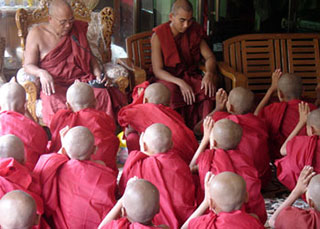
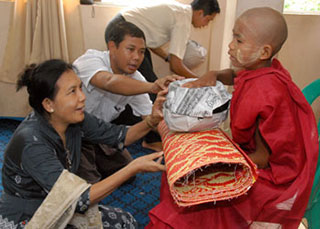
Then she would make her obeisance to her heart’s content. The Buddha had prescience that if He did not go to Yasodhaya she would die of grief. Handing his begging bowl to the King father and accompanied by two disciples. He repaired to Yasodhaya’s chamber. There He sat Himself down on the seat of honour set ready for Him. Yasodhaya was at His feet in all haste and clasping His two ankles in her two hands she pressed her face on His feet and smothered them in her tears. Thus she made obeisance to the Buddha. her beloved Lord. For some time the Buddha stayed at His father’s city teaching His law to the people.
One day Rahula’s mother told him to go to his Father and claim his heritage. The young prince went to his Father. the Buddha and said. “Father. give me my heritage.” The Buddha put Rahula in the care of His disciple. Sariputra. Rahula was given the Yellow Robe. This was his glorious heritage.
The Buddha’s heritage
Now our nine-year-old son was going to receive the heritage the Buddha had given to his own son two thousand five hundred years ago. Our son was to be the Buddha’s own kin; we were giving him up into the holy order of the Yellow Robe. It is then that a Buddhist marriage. which in itself has no place in religion. finds its highest fulfilment as the means of rendering onto the Order the flesh of one’s flesh. the bone of one’s bone. We were up in the clouds during the days of planning and shopping. Yellow robes and all the paraphernalia of novices were got ready. On the appointed day. we left home for the monastery. Ko Latt carrying the yellow robes. Daw Daw and the girls carrying gifts for the monks. Khin Maung Win was dressed in silk longyi and long sleeved shirt. Since we were cutting down on the show. we had no princely dresses; no horseback ride and gilded umbrella for him.
Almsgiving; novitiation ceremony.
We gave the hundred and fifteen monks in the monastery their morning meal. It was an unforgetable sight; the yellow-robed monks partaking of the morning meal. After the morning duties were done. the boy and his two companions had their heads shaved. Ko Latt and I held a snow-white sheet to receive his hair which we buried near a pagoda. Then the boys were led to the monk who was to be their teacher. Each with a roll of yellow robe cupped in both hands. they begged permission in Pali to be novitiated.
The monk invested them with the robes. We picked up our son’s wordly attire and there he stood looking pure and serene in yellow robes. yet so young and so tender. My eyes were filled with tears of joy. How could our love. Ko Latt’s and mine. bring forth something so sublime? We prostrated ourselves at his feet and paid obeisance to him. who was no longer our son but the Son of the Buddha.
The boy’s stay at the monastery
The boy stayed in the monastery for nine days during which he had to keep the ten precepts. one of which was to abstain from solid food after the hour of noon. Naturally we were worried about whether the boy could do without his evening meal. He was given lime juice in the evening and he took to his new way of life quite easily. In a place where no one ate in the afternoon it was easy to adapt himself. Going without the evening meal eliminates all the work and fuss and leaves more time for study and meditation. Young people keep fit and strong enough as a result of this act of self-denial.
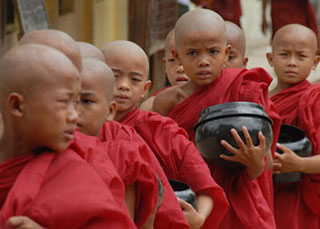
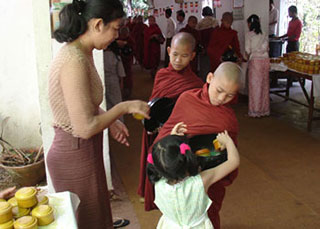
A young novice’s alms round
Every morning our son came with the older novices. each carrying his black bowl. We put rice and curry and delicacies into the bowl. Since the novitiation. our son had become another person altogether. Apart from respecting his shorn head. the yellow robe and a new pali name. we had to speak to him in honorific terms. We no longer called him by his layman’s name and he addressed us “Lay-sister” or “Lay-brother”. We were no longer his parents. just lay-people. for he had become a Son of the Buddha. All this brought us a strange feeling of ecstasy. Our son’s novitiation brought back the sense of wonder I had known in my younger days. The monastery where he stay was a somewhat like the ones I had seen when I was a child. The monks were staid and quiet andspent their days in meditation and the study of the Buddhist scriptures.

Comment (0)